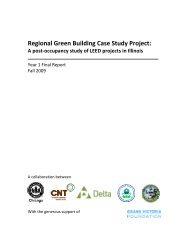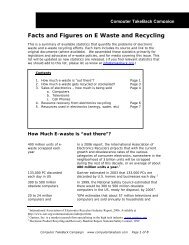CEA 2010 Sustainability Report - Consumer Electronics Association
CEA 2010 Sustainability Report - Consumer Electronics Association
CEA 2010 Sustainability Report - Consumer Electronics Association
Create successful ePaper yourself
Turn your PDF publications into a flip-book with our unique Google optimized e-Paper software.
To achieve these goals, CE companies are<br />
implementing initiatives to reduce fossil fuel<br />
energy consumption, including generating and<br />
purchasing renewable energy, using cleaner<br />
modes of transport and reducing business travel.<br />
In addition, CE companies are increasing their<br />
operational energy efficiency by designing and<br />
installing energy efficient technologies, such<br />
as manufacturing equipment, lighting, HVAC<br />
and IT systems. CE companies have also made<br />
significant reductions in energy consumption<br />
at their data centers.<br />
Data Center Energy Efficiency<br />
Data center facilities manage digital information<br />
that is essential to the functioning of business,<br />
communications, academic and governmental<br />
systems. Increasing demand for data processing<br />
and storage has caused a growth in global data<br />
center capacity and power use that is contributing<br />
to global greenhouse gas emissions. In 2006,<br />
the U.S. Environmental Protection Agency (EPA)<br />
estimated that servers and data centers in the<br />
U.S. consumed about 61 billion kWh of energy —<br />
equivalent to 1.5 percent of total U.S. electricity<br />
consumption. To reduce electricity use, lower<br />
utility bills and minimize their environmental<br />
impacts, many CE companies are working to<br />
reduce fossil fuel consumption and improve<br />
data center energy efficiency by:<br />
n utilizing data center infrastructure designs<br />
that reduce power loss (e.g. through<br />
improved cooling and power conditioning);<br />
n consolidating applications from many servers<br />
to one server;<br />
n installing more efficient equipment, including<br />
ENERGY STAR qualified servers; and<br />
n purchasing renewable energy and/or reusing<br />
waste heat energy.<br />
The industry is also working to develop a<br />
common set of tools and metrics for energy<br />
efficiency. For example, The Green Grid —<br />
a global consortium of IT companies and professionals<br />
(including representatives from HP, Intel,<br />
AMD, Dell, Microsoft and APC) — recently<br />
developed Power Usage Effectiveness (PUE)<br />
and Data Center infrastructure Efficiency (DCiE)<br />
metrics. These measurement systems enable<br />
data center operators to estimate the energy<br />
efficiency of their data centers, compare the<br />
results against other data centers, and measure<br />
improvements over time. In <strong>2010</strong>, the U.S. EPA<br />
also announced that stand-alone data centers<br />
and buildings that house large data centers can<br />
earn the ENERGY STAR label if their energy<br />
efficiency performance is in the top 25 percent<br />
of their peers.<br />
In addition, many CE members meet each year<br />
at the Data Center Efficiency Summit to discuss<br />
best practices and new technologies for improving<br />
data center energy efficiency. Examples of<br />
CE companies that have achieved significant<br />
energy and cost savings from gains in data<br />
center efficiency include:<br />
n AT&T — reduced its energy intensity in 2009<br />
by 23.8 percent compared with the previous<br />
year by using 498 kWh per terabyte of data<br />
carried on its network. The company has set a<br />
goal to further reduce electricity consumption<br />
in <strong>2010</strong> relative to data growth on its network<br />
by 16 percent compared to 2009.<br />
n Microsoft — The Power Usage Effectiveness<br />
(PUE) average for the data centers it owns was<br />
1.53 in 2009. Microsoft is working aggressively<br />
to reduce this annual average PUE below 1.2<br />
for all new data center design.<br />
n Intel — implemented a data center efficiency<br />
program in 2007, which involves the consolidation<br />
of the company’s 130 data centers worldwide<br />
into just eight global hubs. To date, Intel<br />
has reduced the number of data centers that<br />
it operates by 16 percent.<br />
E N V I RO N M E NTA L<br />
PERFORMANCE<br />
SUSTAINABLE<br />
PRODUCT DESIGN<br />
SUSTAINABLE<br />
PACKAGING DESIGN<br />
SUSTAINABLE<br />
FACILITIES<br />
SUSTAINABLE<br />
TRANSPORT<br />
& DELIVERY<br />
ENERGY<br />
EFFICIENCY<br />
ECYCLING<br />
SOCIAL<br />
PERFORMANCE<br />
SOCIAL<br />
CONTRIBUTIONS<br />
CORPORATE<br />
SUSTAINABILITY<br />
REPORTING<br />
CE A <strong>2010</strong><br />
SUSTAINABILIT Y<br />
REPORT<br />
23















